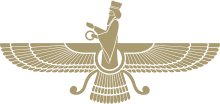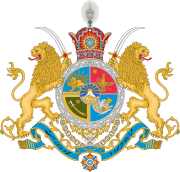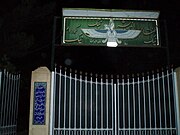Faravahar


| Part of a series on |
| Zoroastrianism |
|---|
 |
|
|
The Farvahar (Persian: فَرْوَهَر), also known as the Foruhar (فروهر) or the Farre Kiyâni[1] (فر کیانی), is one of the best-known symbols of Zoroastrianism, an Iranian religion. There are various interpretations of what the Faravahar symbolizes, and there is no concrete universal consensus on its meaning. However, it is commonly believed that the Faravahar serves as a Zoroastrian depiction of the fravashi, or personal spirit.[2][3]
The Faravahar is one of the best-known and most used pre-Islamic symbols of Iran and is often worn as a pendant. Despite its traditionally religious nature, it has become a secular and cultural symbol for Iranians.[4][5][6]
Etymology
The
History

The pre-Zoroastrian use of the symbol originates as the
In Zoroastrian culture

The faravahar was depicted on the tombs of Achaemenid kings, such as
Whilst being used by both modern day Zoroastrians and Persians, it is important to note the symbol is neither Zoroastrian nor Persian in its origin. It originates as a Mesopotamian Assyrian depiction of the wing deity Ashur. After the Achaemenian dynasty, the image of the farohar was no longer[citation needed] present in Persian art or architecture. The Parthians, Sassanians and Islamic kings that followed did not use the image. It was not until the 20th century,[citation needed] over 2000 years later,[citation needed] that the symbol re-emerged thanks to the work of Parsi scholar, Jamshedji Maneckji Unvala, who published two articles in 1925 and 1930.[12][13]
Unvala's work was discredited by Irach Jehangir Sorabji Taraporewala, who refuted the idea that the winged figure represented Ahura Mazda. Taraporewala suggested that the figures used in Persian reliefs were meant to depict khvarenah or royal glory to reflect the perceived divine empowerment of kings, and, therefore, has no true spiritual meaning. This view was later supported by Alireza Shapour Shahbazi and Mary Boyce.[14][15][16]
Modern age usage
The Sun Throne, the imperial seat of Iran, has visual implications of the Farahavar. The sovereign would be seated in the middle of the throne, which is shaped like a platform or bed that is raised from the ground. This religious-cultural symbol was adapted by the Pahlavi dynasty to represent the Iranian nation.[17] In modern Zoroastrianism, one of the interpretations of the faravahar is that it is a representation of the human soul and its development along with a visual guide of good conduct.[18] Another popular interpretation is that it is a visual representation of a Fravashi, though Fravashis are described in Zoroastrian literature as being feminine.[2] One of the most prevalent views in academia as to the meaning of the faravahar is that it represents Khvarenah, the divine power and royal glory.[2] Although there are a number of interpretations of the individual elements of the symbol, most are recent interpretations and there is still debate as to its meaning.
After the
Gallery
-
Achaemenidcylinder seal.
-
Zoroastrianism tomb, Sulaymaniyah, Kurdistan Region.
-
Stone carved Faravahar in Persepolis, Iran.
-
The Faravahar portrayed in the Behistun Inscription, Iran.
-
Foroohar (Farvahar) symbol, on top of the Ferdowsi mausoleum.
-
National bank of Iran (1946) containing the Farvahar icon.
-
Faravahar symbol on a Fire temple in Yazd, Iran.
-
Imperial coat of arms of Iran prior to the Revolution, containing Faravahar icon.
-
Persepolis, Iran.
-
Museum of Zoroastrians, Kerman, Iran.
-
Faravahar icon at top of the Suez inscriptions of Darius the Great.
-
Faravahar on the gate of a Zoroastrian temple, Iran.
Citations
- ^ book_rahnamaye_TakhteJamshid. Author: Shahpoor Shahbazi
- ^ a b c d Boyce 2000, pp. 195–199.
- ^ "FRAVAŠI – Encyclopaedia Iranica". www.iranicaonline.org. Retrieved 4 April 2020.
- ^ "Europe | The Identity Necklace: Being Iranian in Britain". FRONTLINE - Tehran Bureau. Retrieved 4 April 2020.
- ^ staff, T. O. I.; Agencies. "Iran official: If US attacks, Israel will be destroyed in half an hour". www.timesofisrael.com. Retrieved 4 April 2020.
- ISSN 1573-384X.
- ISBN 0-19-713559-5.
- ^ Parpola, Simo (July 1993). "The Assyrian Tree of Life: Tracing the Origins of Jewish Monotheism and Greek Philosophy" (PDF). The University of Chicago Press. 52 (3): 161–208. Retrieved 4 November 2020.
- ^ Olbrycht 2016, p. 93.
- ^ Olbrycht 2016, p. 94.
- ^ "FERDOWSI, ABU'L-QĀSEM iii. MAUSOLEUM – Encyclopaedia Iranica". www.iranicaonline.org. Retrieved 14 July 2019.
- )
- OCLC 891516152.
- OCLC 154674597.
- ISBN 978-90-04-29390-8
- ^ Shahbazi, A. S. 1974 An Achaemenid Symbol, I A Farewell To ' Fravahr' And ' Ahuramazda.' AMI 7 135 144.
- ^ "ZOROASTRIANS OF 19TH-CENTURY YAZD AND KERMAN – Encyclopaedia Iranica". www.iranicaonline.org. Retrieved 14 July 2019.
- ^ a b "What Does the Winged Symbol of Zoroastrianism Mean?". About.com Religion & Spirituality. Archived from the original on 19 April 2016. Retrieved 26 January 2017.
- ISBN 0-520-24262-9.
General sources
- Boyce, M. (2000). "Fravaši". Encyclopaedia Iranica. Vol. X, Fasc. 2. pp. 195–199.
- Curtis, Vesta Sarkhosh (2007). "Religious iconography on ancient Iranian coins". Journal of Late Antiquity. London: 413–434.
- Olbrycht, Marek Jan (2016). "The Sacral Kingship of the early Arsacids. I. Fire Cult and Kingly Glory". Anabasis. Studia Classica et Orientalia: 91–106.
External links
 Media related to Faravahar at Wikimedia Commons
Media related to Faravahar at Wikimedia Commons












